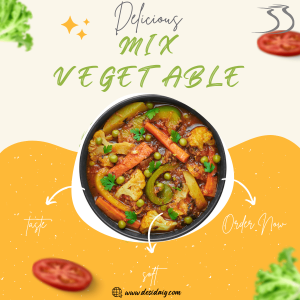Saag Sarson Daig
In the grand canvas of Indian culinary arts, the Saag Sarson Daig paints a vivid picture of Punjab’s agrarian legacy and its rich cultural tapestry. This dish, a luscious blend of mustard greens and spinach, cooked slowly in a large Daig, is more than just a meal; it’s a celebration of life, tradition, and the bounty of the land. As we delve into the essence of Saag Sarson Daig, we uncover the layers of its preparation, its roots in Punjabi cuisine, and the communal joy it brings to every festivity.
The Essence of Saag Sarson
Ingredients: The Heart of the Dish
Saag Sarson Daig begins with the freshest mustard greens (Sarson) and spinach, combined in a melody that’s both nutritious and flavorful. The greens are meticulously cleaned, chopped, and then boiled to perfection. The addition of maize flour not only thickens the saag but adds a subtle earthiness that is characteristic of this dish. A concoction of ginger, garlic, onions, and a bespoke blend of spices, sautéed in rich butter or ghee, introduces a layer of complexity and warmth to the dish.
Traditional Cooking Methods
The art of preparing Saag Sarson Daig is steeped in tradition, requiring patience and a deep understanding of Punjabi cooking techniques. The greens, once boiled and blended, are simmered in a Daig—a large, heavy-bottomed cooking vessel that allows for slow cooking over an extended period. This method ensures that the flavors meld beautifully, and the greens attain a velvety texture that’s unparalleled.
A Culinary Journey Through Regional Flavours
Saag Sarson Daig is synonymous with Punjabi cuisine, embodying the spirit of the region’s agricultural heritage. It’s a dish that’s traditionally prepared during the winter months, especially for celebrations like Lohri and Vaisakhi, marking the harvest season. Each household in Punjab has its own rendition of this dish, with variations that might include different proportions of greens or the addition of other winter vegetables.
Serving Traditions and Pairings
Served in a Daig, this dish becomes the centerpiece of any meal, inviting everyone to partake in its rustic warmth. Traditionally, Saag Sarson is enjoyed with Makki di Roti—cornmeal flatbreads that complement the creamy texture of the saag. Toppings of fresh butter or dollops of ghee add an extra layer of decadence, while sides of jaggery and pickled onions cut through the richness, offering a delightful contrast.
Nutritional Insights
Beyond its comforting flavors, Saag Sarson Daig is a powerhouse of nutrition. Rich in vitamins A and C, iron, and antioxidants, it’s a dish that not only warms the soul but nourishes the body. The greens used in Saag Sarson are known for their health benefits, including anti-inflammatory properties and the ability to boost immunity.
Conclusion
Saag Sarson Daig is more than just a dish; it’s a symbol of Punjabi pride and hospitality, a testament to the region’s love for flavors that are as bold as they are nurturing. It represents a culinary tradition that has been passed down through generations, a communal feast that brings families and friends together. As we savor Saag Sarson Daig, we celebrate the rich cultural heritage of Punjab, embracing the warmth and generosity that Indian cuisine is known for.
Sarso saag is a traditional Pakistani and Indian dish made with mustard greens. The greens are cooked with spices and served with roti or rice. Sarso saag is a popular dish in India and Pakistan. It is often made during the winter months. The dish is said to be originated in the state of Punjab and gets its name from the Urdu word for mustard, sarso. Saag is usually made with spinach, fenugreek, and other leafy greens. The greens are first boiled until they are soft and then pureed before being cooked with spices like ginger, garlic, onion, and green chili. saag is typically served with roti or rice and some pickled vegetables on the side.
Benefits of saag sarso:
SAAG SARSO (also known as Sesame Oil) is an incredibly versatile and healthy herb. Its benefits include improving digestion, relieving constipation, and improving heart health. This herb is also known to boost the immune system, fight inflammation, and protect against cancer.
One of the most impressive things about SAAG is its ability to improve digestion. It does this by stimulating the production of digestive juices and enzymes. This helps the body to better break down food and absorb nutrients. Additionally, SAAG can help to relieve constipation by increasing bowel movements.
saag sarso for heart patient:
Another great benefit of SAAG SARSO is its positive effect on heart health. This herb has been shown to lower cholesterol levels and improve circulation. Additionally, it can help to prevent blood clots from forming. This makes SAAG an excellent choice for those at risk for heart disease or stroke.
In addition to its digestive and cardiovascular benefits, SAAG SARSO is known for its ability to boost the immune system, fight inflammation, and protect against cancer. The antioxidants in this herb help neutralize free radicals in the body, which can damage cells and lead to disease. Additionally, SAAG has anti-inflammatory properties that can help to reduce pain and swelling associated with conditions like arthritis. Finally, this herb contains compounds that may help to prevent cancer cells from growing or spreading in the body.
Recipe:
SAAG SARSO is a popular Indian recipe that can be made with either spinach or mustard greens. It is typically served with rice and chapati and is a good source of protein, iron, and vitamins A and C. To make SAAG , first, wash and chop the greens. Then, sauté the greens in oil until they are wilted. Add garlic, ginger, and other desired spices, and cook for another minute. Finally, add water or stock and simmer until the greens are tender. Serve over rice or chapati, and enjoy!
Ingredients:
SARSO SAAG is a popular Indian dish made with spinach and mustard greens. The saag are cooked with spices, ginger, and garlic, then pureed to create a flavorful and healthy dish.











There are no reviews yet.